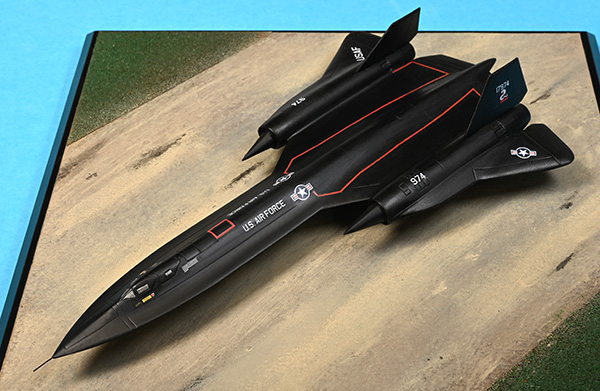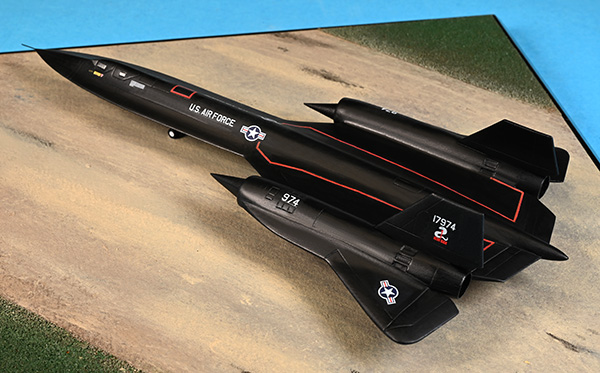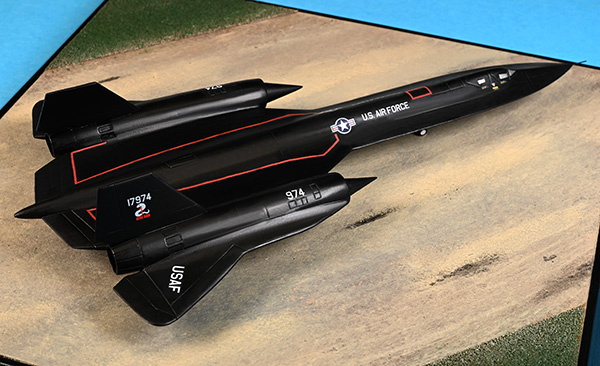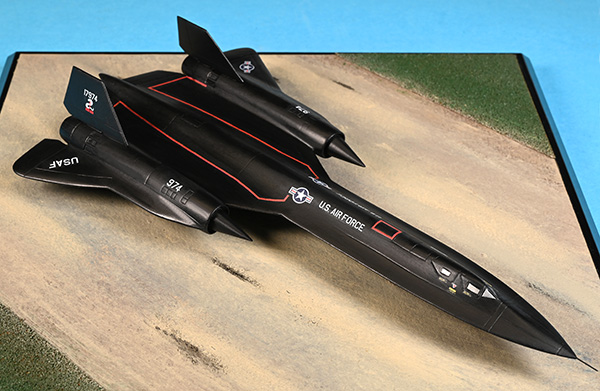Lockheed SR-71A ‘Blackbird’
Lockheed SR-71A Blackbird
2025/61-7974 “ICHI-BAN” Det 1 9th SRW
Kaneda AB, Okinawa, September 1968.
The SR-71A Blackbird was developed as a black project from the Lockheed A-12 reconnaissance aircraft during the 1960s by Lockheed’s Skunk Works division. The famous American aerospace engineer Clarence “Kelly” Johnson was responsible for many of the aircraft’s innovative concepts. The shape of the SR-71 was based on that of the A-12, which was one of the first aircraft to be designed with a reduced radar cross-section. At one point, a bomber variant of the aircraft was under consideration, before the program was focused solely on reconnaissance. Mission equipment for the reconnaissance role included signals intelligence sensors, a side-looking airborne radar, and a photo camera. The entirely unarmed SR-71 was both longer and heavier than the A-12, allowing it to hold more fuel as well as a two-seat cockpit.
The SR-71A Blackbird designation has been attributed to lobbying efforts by USAF Chief of Staff General Curtis LeMay, who preferred the SR (Strategic Reconnaissance) designation over simply RS (Reconnaissance). The aircraft was introduced to operational service in January 1966.
During aerial reconnaissance missions, the SR-71A Blackbird operated at high speeds and altitudes (Mach 3.2 and 85,000 feet, 25,900 meters) to allow it to outrace threats. If a surface-to-air missile launch was detected, the standard evasive action was simply to accelerate and out-fly the missile. On average, each SR-71A Blackbird could fly once per week due to the extended turnaround required after mission recovery. A total of 32 aircraft were built; 12 were lost in accidents with none lost to enemy action. During 1988, the USAF retired the SR-71A Blackbird largely due to political reasons; several were briefly reactivated during the 1990s before their second retirement in 1998. NASA was the final operator of the type, retiring their examples in 1999.
On some Pacific Islands, there exists a deadly, black venomous pit viper called the Habu. When the top secret brainchild of Kelly Johnson and the Skunk Works, none other than the worlds fastest air breathing aircraft, the A-12, and later SR-71As first flew into their remote base of Kadena AFB, Okinawa, the local people couldn’t help but notice the strange and menacing shape thundering in the sky. The Titanium monster came to be known as Habu, as did the crews that flew her. One of the first Habu to appear over Kadena, was Number 974, and on March 21st 1968, USAF SR-71A Blackbird #974 flew the First Operational sortie over Vietnam, piloted by Jerry O’Malley and RSO Ed Paine. #974 went on to become the Blackbird which flew the most operational missions, and for each mission flown, a Habu was painted on her side. Once the crew amassed more than 5 Habu snakes, they were considered aces.
In recognition of having the most operational missions, a large Habu, wrapped around a red number 1 was painted on the tails of #974. She became known as “ICHI-BAN” translated as “number one” in the local language.
On April 21st, 1989, Blackbird #61-17974, better known as “Ichi-Ban” departed Kadena on a mission. At the controls were Pilot Lt. Col Dan House, and RSO Blair Bozek. As #974 accelerated through three times the speed of sound, the left compressor bearing froze, causing the immediate disintegration of the port engine, and resultant explosion from the catastrophic failure sending shrapnel through critical hydraulic lines. Lt Col House managed to slow #974, and even descend below 10 thousand feet. Both crew ejected safely, and were quickly rescued by local fishermen in the waters below. The technologically sensitive remains of ‘ICHI BAN’ were recovered as a matter of haste and returned to Kadena Air Base on Okinawa. The disposal of the wreckage had now become a problem. Classifying it as scrap it was decided that in recognition of the service performed by ‘ICHI-BAN’ a descision was taken. The wreckage was taken by ship to a classified location and ‘buried at sea’ with full military honors at 1157 on Christmas Eve 1989, several hundred miles from Okinawa, 25,597 feet down in the Mariana Trench.
Only one of the two section seats from Habu #974 was recovered. According to legend, the other ejection seat, having never been found, was allegedly being used by a local tribal chief as his personal throne.
As SR-71A Operations came to a close in 1990, the DET 1 commander had a plaque placed on a hill that overlooked the base, that came to be known as ‘Habu Hill’. This vantage point is dedicated to the magnificent SR-71A Blackbird, known worldwide as the Habu. The first SR-71A Blackbird arrived at Kadena Air Base on 9 March 1968 and the last aircraft departed on 21 January 1990. Throughout those twenty-two years, the Habu roamed Pacific skies unchallenged in war and peace to insure the freedom of the United States and her allies. Habu Hill stands as a memorial to the SR-71A Blackbird, and to the special men and women who sustained its strategic reconnaissance missions.
Since its retirement, the SR-71’s role has been taken up by a combination of reconnaissance satellites and unmanned aerial vehicles (UAVs); a proposed UAV successor, the Lockheed Martin SR-72, has not yet been pursued. The SR-71 has been given several nicknames, including “Blackbird” and “Habu”. As of 2020, it still holds the world record it set in 1976 for the fastest air-breathing manned aircraft, previously held by the related Lockheed YF-12.
Scale 1:144 Wingspan 4.63” (117.6 mm)
Base size 9.33″ (237 mm) square (No. 6)
Weight not including base 13.4 ozs (380 grams)
Limited edition of 25 only
SOLD OUT





